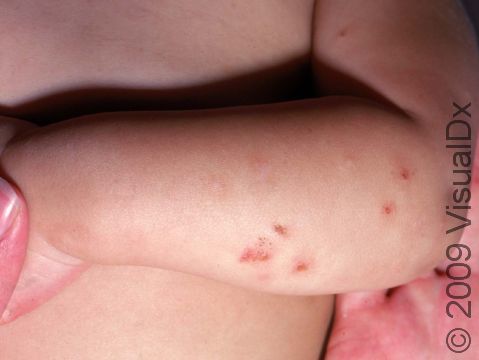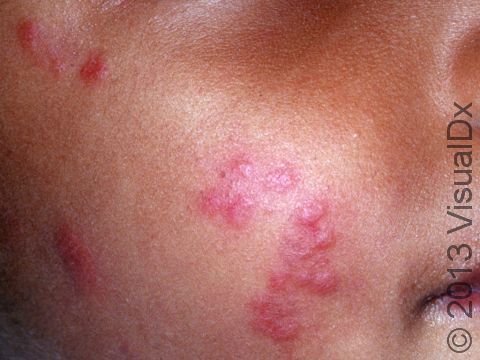Bug Bite or Sting (Pediatric)
As one of the most frequent causes for visits to the doctor’s office, insect bites and/or stings are quite common among infants. While bites and stings on an infant are typically just an inconvenience, some reactions can be life threatening. The severity of an insect bite will vary from child to child, and only a small minority of infants develops this severe reaction (anaphylaxis).
It is important to get immediate medical attention for a severe reaction to a bite or sting, such as those that may occur with stings from bees, wasps, and hornets. Most insects (such as ants, mosquitoes, flies, spiders, ticks, and mites) do not cause such a severe reaction.
A bee will occasionally leave behind a stinger attached to a venom sac. It is important to try and remove it as soon as possible. Wasps, on the other hand, do not leave their stingers in the skin after stinging, which means they can sting more than once.
Who's At Risk?
Infants of both sexes are just as likely to get stung. While an infant may be seriously affected by an insect bite, it is not always true that other family members will be equally affected by the same type of bite. Heredity does not play a factor in how any given person will react to a bite or sting.
Signs & Symptoms
Insect bites usually appear as small, itchy, red bumps, occasionally with a blister. Infants may be more prone to developing a blister than older children. Some insects, such as fire ants, can cause a painful and itching raised area containing pus (a pustule).
Flying insects tend to bite exposed areas not covered by clothing, while some bugs (such as fleas) focus on the lower legs. Bedbugs prefer the head and neck area, often biting several times in the same area and leaving a group of lesions.
Common reactions to arthropod stings may include:
- Redness, pain, and swelling
- Severe reactions such as facial swelling, difficulty breathing, and shock
(anaphylaxis) - Fever, hives, and painful joints (though these reactions are not as common)
Very few spiders cause severe reactions. The black widow spider may cause only a mild reaction at the bite site, but pain, stiffness, chills, fever, nausea, and abdominal pain may follow within a few hours. Similarly, the bite of a brown recluse spider may cause a severe skin reaction after a few hours, with redness, pain, blistering, and ulcers forming, as well as fever, nausea, and fatigue.
Self-Care Guidelines
For stings:
- Bees may leave a stinger behind. Try to gently scrape the stinger off with a blunt object, such as a credit card.
- Wash the wound with soap and water.
- Apply an ice pack or cold water for a few minutes.
- Take acetaminophen (Tylenol®) for pain and an antihistamine (diphenhydramine or chlorpheniramine) for itching, as needed.
For insect bites:
- Wash with soap and water.
- Apply cool compresses.
- Use antihistamines to relieve itching and take acetaminophen (Tylenol®) for pain.
- Apply 1% hydrocortisone cream to help reduce the itching.
For ticks (still attached):
- Using tweezers, grasp the tick as near the skin as possible, and pull firmly
until it releases. - Swab the area with alcohol or soap and water.
- Save the tick for identification, if needed.
- Wash the area with soap and water, and then apply 1% hydrocortisone in case a reaction occurs.
Treatments
Depending on the type of insect bite and how your child reacts to it, your child’s doctor might treat him or her in a number of ways.
For insect bites:
- Prescription topical corticosteroids
- Muscle relaxants
- Pain medicines
- An antidote against the specific toxin (antivenin)
- Antibiotics
- Sometimes surgery at the affected area, if the insect bite is severe
For stings:
- Antihistamines or corticosteroids
- Epinephrine
- Antihistamines
- Corticosteroids
- Injected (intravenous) fluids and oxygen for shock (anaphylaxis)
- Injectable epinephrine if your child is known to have severe allergic reactions
- Procedures to stimulate the immune system (immunotherapy) to reduce the chance of repeated severe reactions
Visit Urgency
Some insect (arthropod) bites/stings are more dangerous than others. If you suspect your child might have a black widow or brown recluse spider bite, apply ice to the area and seek medical assistance immediately.
Symptoms of these bites include:
- A deep blue or purple area around the bite, often with a surrounding white
area and a red outer ring - Abdominal pain
- Headache
- Fever
- Fatigue
- Nausea
- Muscle stiffness
If the area of a tick bite becomes red or swollen, or if the affected area spreads outward, seek medical help to check for Lyme disease.
When dealing with stings, watch out for symptoms such as:
- Hives, itching, or swelling in areas beyond the sting site
- Swelling of the lips or throat
- Tightness in the chest or difficulty breathing
- Hoarse voice or tongue swelling
- Dizziness or loss of consciousness
Trusted Links
References
Bolognia, Jean L., ed. Dermatology, pp.405. New York: Mosby, 2003.
Freedberg, Irwin M., ed. Fitzpatrick’s Dermatology in General Medicine. 6th ed. pp.2289, 2291, 2295-2298. New York: McGraw-Hill, 2003.
Last modified on August 16th, 2022 at 2:45 pm

Not sure what to look for?
Try our new Rash and Skin Condition Finder



